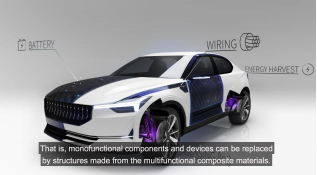2024-09-11 チャルマース工科大学
<関連情報>
- https://news.cision.com/chalmers/r/world-s-strongest-battery-paves-way-for-light–energy-efficient-vehicles,c4036183
- https://onlinelibrary.wiley.com/doi/10.1002/adma.202409725
- https://onlinelibrary.wiley.com/doi/10.1002/aesr.202000093
- https://iopscience.iop.org/article/10.1088/2399-7532/aab707/meta
多機能炭素繊維構造電池を公開 Unveiling the Multifunctional Carbon Fiber Structural Battery
Richa Chaudhary, Johanna Xu, Zhenyuan Xia, Leif E. Asp
Advanced Materials Published: 10 September 2024
DOI:https://doi.org/10.1002/adma.202409725

Abstract
Structural batteries refer to the multifunctional device capable of both storing electrical energy and bearing mechanical loads concurrently. In this context, carbon fibers emerge as a compelling choice of material and serve dual purpose by storing energy and providing stiffness and strength to the battery. Previous investigation has demonstrated proof-of-concept of functional positive electrodes against metallic lithium in structural battery electrolyte. Here, an all-carbon fiber-based structural battery is demonstrated utilizing the pristine carbon fiber as negative electrode, lithium iron phosphate (LFP)-coated carbon fiber as positive electrode, and a thin cellulose separator. All components are embedded in structural battery electrolyte and cured to provide rigidity to the battery. The energy density of structural battery is enhanced by use of the thin separator. The structural battery composite demonstrates an energy density of 30 Wh kg−1 and cyclic stability up to 1000 cycles with ≈100% of Coulombic efficiency. Remarkably, the elastic modulus of the all-fiber structural battery exceeds 76 GPa when tested in parallel to the fiber direction – by far highest till date reported in the literature. Structural batteries have immediate implication in replacing structural parts of electric vehicles while reducing the number of conventional batteries. Thus, offering mass savings to future electric vehicles.
構造電池とその多機能性能 A Structural Battery and its Multifunctional Performance
Leif E. Asp, Karl Bouton, David Carlstedt, Shanghong Duan, Ross Harnden, Wilhelm Johannisson, Marcus Johansen, Mats K. G. Johansson, Göran Lindbergh, Fang Liu, Kevin Peuvot …
Advanced Energy and Sustainability Research Published: 27 January 2021
DOI:https://doi.org/10.1002/aesr.202000093

Abstract
Engineering materials that can store electrical energy in structural load paths can revolutionize lightweight design across transport modes. Stiff and strong batteries that use solid-state electrolytes and resilient electrodes and separators are generally lacking. Herein, a structural battery composite with unprecedented multifunctional performance is demonstrated, featuring an energy density of 24 Wh kg−1 and an elastic modulus of 25 GPa and tensile strength exceeding 300 MPa. The structural battery is made from multifunctional constituents, where reinforcing carbon fibers (CFs) act as electrode and current collector. A structural electrolyte is used for load transfer and ion transport and a glass fiber fabric separates the CF electrode from an aluminum foil-supported lithium–iron–phosphate positive electrode. Equipped with these materials, lighter electrical cars, aircraft, and consumer goods can be pursued.
炭素繊維リチウムイオン構造電池電極のグラファイト微細構造と性能 Graphitic microstructure and performance of carbon fibre Li-ion structural battery electrodes
Giulia Fredi, Steffen Jeschke, Athmane Boulaoued,,, Joachim Wallenstein, Masoud Rashidi, Fang Liu, Ross Harnden, Dan Zenkert, Johan Hagberg, Göran Lindbergh
Multifunctional Materials Published: 28 August 2018
DOI:10.1088/2399-7532/aab707
Abstract

Carbon fibres (CFs), originally made for use in structural composites, have also been demonstrated as high capacity Li-ion battery negative electrodes. Consequently, CFs can be used as structural electrodes; simultaneously carrying mechanical load and storing electrical energy in multifunctional structural batteries. To date, all CF microstructural designs have been generated to realise a targeted mechanical property, e.g. high strength or stiffness, based on a profound understanding of the relationship between the graphitic microstructure and the mechanical performance. Here we further advance this understanding by linking CF microstructure to the lithium insertion mechanism and the resulting electrochemical capacity. Different PAN-based CFs ranging from intermediate- to high-modulus types with distinct differences in microstructure are characterised in detail by SEM and HR-TEM and electrochemical methods. Furthermore, the mechanism of Li-ion intercalation during charge/discharge is studied by in situ confocal Raman spectroscopy on individual CFs. Raman G band analysis reveals a Li-ion intercalation mechanism in the high-modulus fibre reminiscent of that in crystalline graphite. Also, the combination of a relatively low capacity of the high-modulus CFs (ca. 150 mAh g−1) is shown to be due to that the formation of a staged structure is frustrated by an obstructive turbostratic disorder. In contrast, intermediate-modulus CFs, which have significantly higher capacities (ca. 300 mAh g−1), have Raman spectra indicating a Li-ion insertion mechanism closer to that of partly disordered carbons. Based on these findings, CFs with improved multifunctional performance can be realised by tailoring the graphitic order and crystallite sizes.



